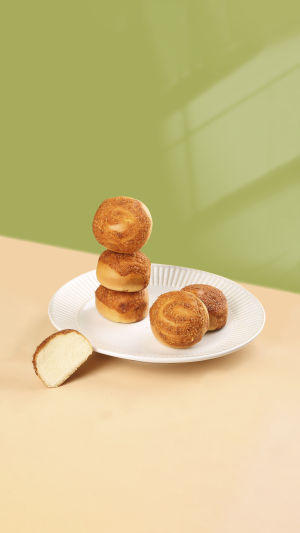Coconut bread, with its delectable combination of flavors and textures, is a beloved treat that incorporates coconut as its star ingredient. Known for its soft dough and sweet coconut filling, this delightful bread is a popular choice for breakfast or an afternoon snack.
Let's delve into the general description of coconut bread:
Dough: The dough for coconut bread typically consists of flour, yeast, sugar, milk, butter, and salt.
It is kneaded, fermented, and baked to achieve a soft and fluffy loaf.
Coconut Filling: The coconut filling is a crucial component of coconut bread, contributing to its rich coconut flavor and delightful sweetness.
It is prepared by combining shredded coconut, sugar, and cream.
Production Steps:
1. In a large bowl, mix together flour, granulated sugar, yeast, and salt. Slowly add warm water while stirring until a sticky dough forms.
2. Incorporate softened butter into the dough, stirring until it is fully absorbed.
3. Transfer the dough onto a flat surface and knead it by hand until smooth and elastic. Return
4. the dough to the bowl, cover it with a damp cloth or plastic wrap and allow it to rise in a warm place until it approximately doubles in size (usually 1-2 hours).
5. While the dough is fermenting, prepare the coconut filling by combining shredded coconut, granulated sugar, and milk. Stir well and set aside.
6. Once the dough has risen, remove it from the bowl and gently deflate it. Roll it out into a rectangle on a work surface.
Evenly spread the coconut filling over the dough, then roll the dough tightly from the long side.
7. Place the rolled dough in a baking tray, make small slits on the surface, cover it with a damp cloth, and let it undergo its final fermentation for about 15-20 minutes. Meanwhile, preheat the oven to 180°C.
8. Transfer the baking tray with the bread to the preheated oven and bake for approximately 25-30 minutes, or until the bread turns golden brown with a delightful aroma. Remove the baked coconut bread from the oven and let it cool completely on a cooling rack.
9. Enjoy coconut bread by slicing it or consuming it as a whole.
Taste and Flavor: Coconut bread boasts a soft and tender texture with a delightful crunch.
It emanates a delightful aroma and offers a rich coconut flavor and sweetness.
Often, a thin layer of icing sugar or shredded coconut is added to the outer layer for added texture and visual appeal.
Variations and Innovations: Coconut bread allows for personal taste and creativity, making it a versatile treat.
Some variations incorporate additional fruits or nuts as toppings, adding layers of flavors and variations.
Coconut bread is a popular pastry enjoyed in various regions.
It can be relished for breakfast, afternoon tea, or dessert, and pairs wonderfully with coffee or tea.
Whether homemade or purchased from a bakery, coconut bread offers a delicious and flavorful option.
Coconut bread also offers several benefits, such as:
1. Delightful Taste: With its sweet and aromatic coconut flavor, coconut bread provides a delightful culinary experience.
2. Nutritional Value: Desiccated coconut, a key ingredient in coconut bread, is rich in fiber, vitamins, minerals, and healthy fats, contributing to its nutritional value.
3. Caloric Energy: Being a carbohydrate-rich food, coconut bread provides energy, making it suitable as a breakfast or pre-activity energy source.
4. Psychological Comfort: The scrumptious nature of coconut bread brings psychological satisfaction and comfort, helping to alleviate stress and anxiety.
5. Health Benefits of Coconut: Coconut is believed to offer various health benefits, including providing antioxidants, boosting the immune system, aiding digestion, and promoting skin health.
However, it's important to note that coconut bread often contains sugar and fat.
Therefore, moderation is key, and it should be enjoyed as part of a balanced diet and a healthy lifestyle.





